2011 Peugeot 308 SW BL towing
[x] Cancel search: towingPage 5 of 356

3
CONTENTS
Direction indicators 135
Hazard warning lamps 135
Horn 135
Tyre under-infl ation detection 136
Emergency or assistance call 137
Braking assistance systems 137
Trajectory control systems 138
Front seat belts 139
Airbags 144�„
�„
�„
�„
�„
�„
�„
�„
�„
SAFETY 135 �Π147
Parking brake 148
Manual gearbox 148
Gear shift indicator 149
Hill start assist 150
6-speed electronic
gear control gearbox 151
Automatic gearbox 155
Stop & Start 158
Speed limiter 161
Cruise control 163
Parking sensors 165�„
�„
�„
�„
�„
�„
�„
�„
�„
�„
DRIVING 148 �Π166
Bonnet 168
Running out of fuel (Diesel) 169
Petrol engines 170
Diesel engines 171
Checking levels 172
Checks 174�„
�„
�„
�„
�„
�„
CHECKS 167 �Π175
Temporary puncture
repair kit 176
Changing a wheel 184
Changing a bulb 191
Changing a fuse 198
Battery 204
Energy economy mode 206
Changing a wiper blade 207
Towing the vehicle 207
Towing a trailer 210
Very cold climate screen 211
Fitting roof bars 212
Accessories 213�„
�„
�„
�„
�„
�„
�„
�„
�„
�„
�„
�„
PRACTICAL
INFORMATION 176 �Π214
Petrol engines 215
Petrol weights 218
Diesel engines 224
Masses Diesel 227
Dimensions 236
Identifi cation markings 237�„
�„
�„
�„
�„
�„
TECHNICAL
DATA 215 �Π238
AUDIO EQUIPMENT
and TELEMATICS 239 �Π338
VISUAL SEARCH 339 �Π345
ALPHABETICAL
INDEX 346 �Π350
Emergency or assistance 239
Peugeot Connect Media 243
Peugeot Connect Navigation 287
Peugeot Connect Sound 319�„
�„
�„
�„
8
910
1112
Page 64 of 356
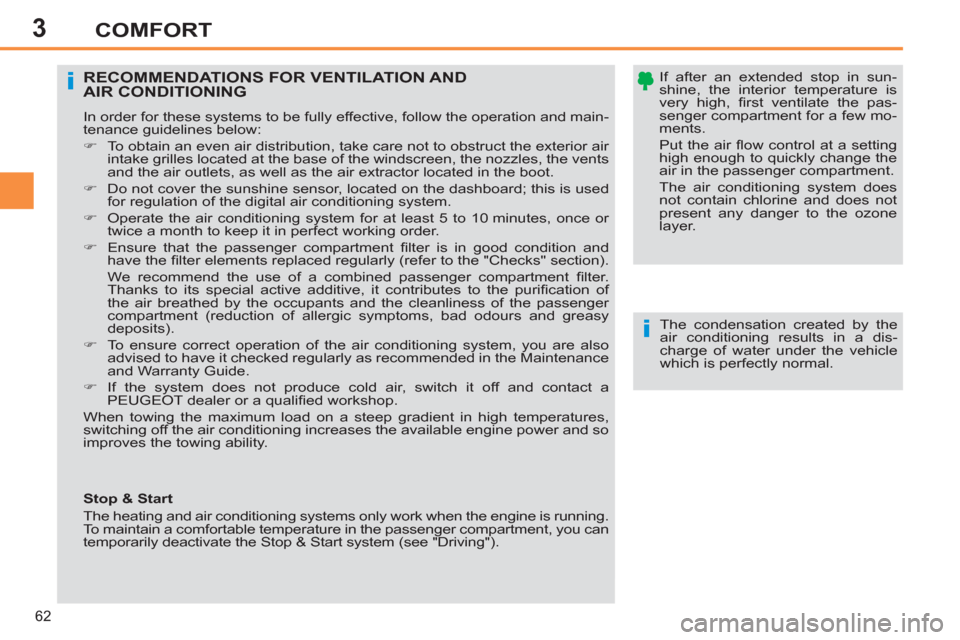
3
i
i
62
COMFORT
If after an extended stop in sun-
shine, the interior temperature is
very high, fi rst ventilate the pas-
senger compartment for a few mo-
ments.
Put the air fl ow control at a setting
high enough to quickly change the
air in the passenger compartment.
The air conditioning system does
not contain chlorine and does not
present any danger to the ozone
layer.
RECOMMENDATIONS FOR VENTILATION AND
AIR CONDITIONING
In order for these systems to be fully effective, follow the operation and main-
tenance guidelines below:
�)
To obtain an even air distribution, take care not to obstruct the exterior air
intake grilles located at the base of the windscreen, the nozzles, the vents
and the air outlets, as well as the air extractor located in the boot.
�)
Do not cover the sunshine sensor, located on the dashboard; this is used
for regulation of the digital air conditioning system.
�)
Operate the air conditioning system for at least 5 to 10 minutes, once or
twice a month to keep it in perfect working order.
�)
Ensure that the passenger compartment fi lter is in good condition and
have the fi lter elements replaced regularly (refer to the "Checks" section).
We recommend the use of a combined passenger compartment fi lter.
Thanks to its special active additive, it contributes to the purifi cation of
the air breathed by the occupants and the cleanliness of the passenger
compartment (reduction of allergic symptoms, bad odours and greasy
deposits).
�)
To ensure correct operation of the air conditioning system, you are also
advised to have it checked regularly as recommended in the Maintenance
and Warranty Guide.
�)
If the system does not produce cold air, switch it off and contact a
PEUGEOT dealer or a qualifi ed workshop.
When towing the maximum load on a steep gradient in high temperatures,
switching off the air conditioning increases the available engine power and so
improves the towing ability.
The condensation created by the
air conditioning results in a dis-
charge of water under the vehicle
which is perfectly normal.
Stop & Start
The heating and air conditioning systems only work when the engine is running.
To maintain a comfortable temperature in the passenger compartment, you can
temporarily deactivate the Stop & Start system (see "Driving").
Page 117 of 356
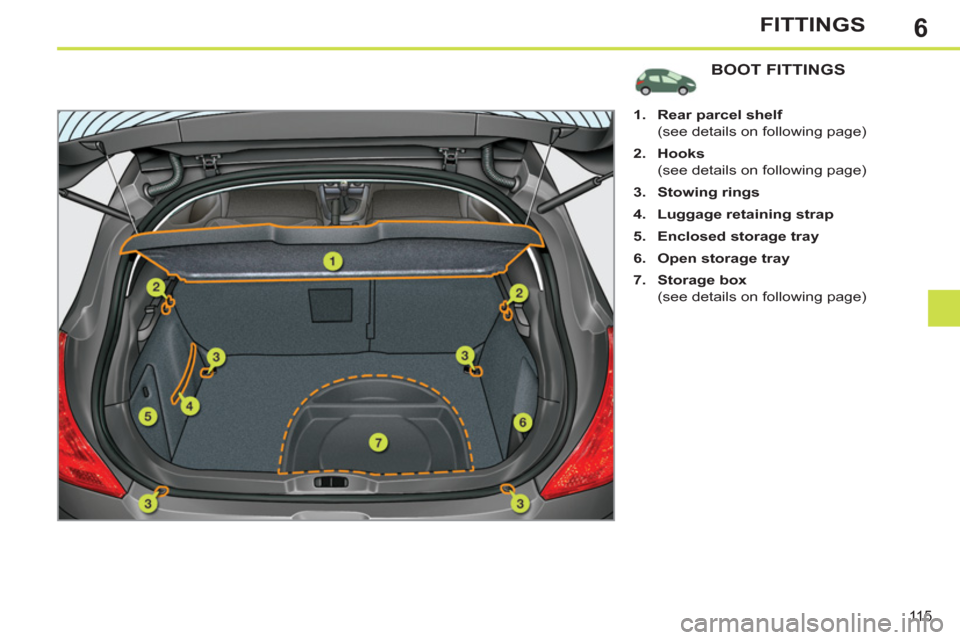
6
11 5
FITTINGS
BOOT FITTINGS
1.
Rear parcel shelf
(see details on following page)
2.
Hooks
(see details on following page)
3.
Stowing rings
4.
Luggage retaining strap
5.
Enclosed storage tray
6.
Open storage tray
7.
Storage box
(see details on following page)
Page 119 of 356
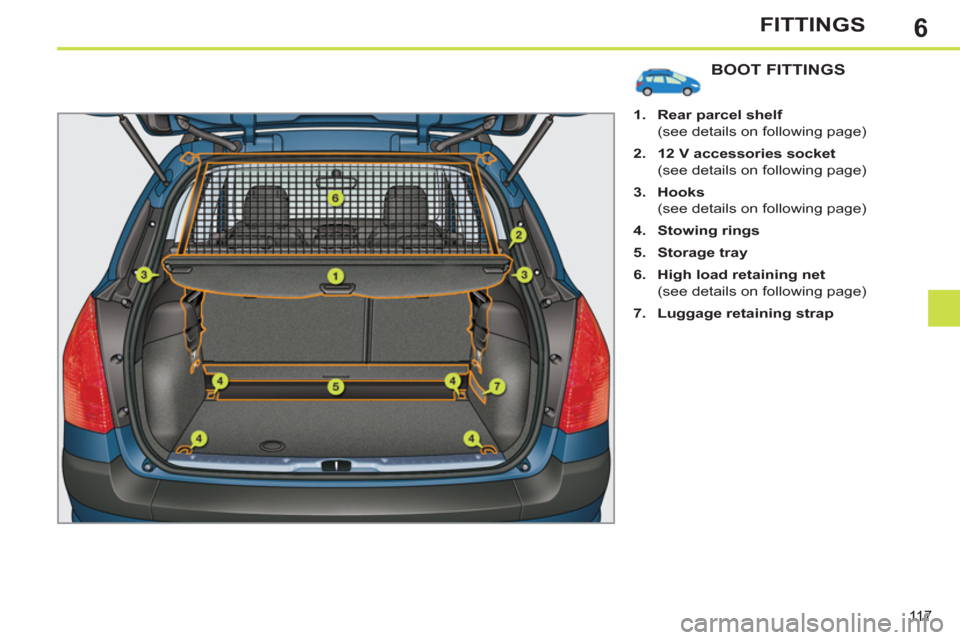
6
11 7
FITTINGS
BOOT FITTINGS
1.
Rear parcel shelf
(see details on following page)
2.
12 V accessories socket
(see details on following page)
3.
Hooks
(see details on following page)
4.
Stowing rings
5.
Storage tray
6.
High load retaining net
(see details on following page)
7.
Luggage retaining strap
Page 122 of 356
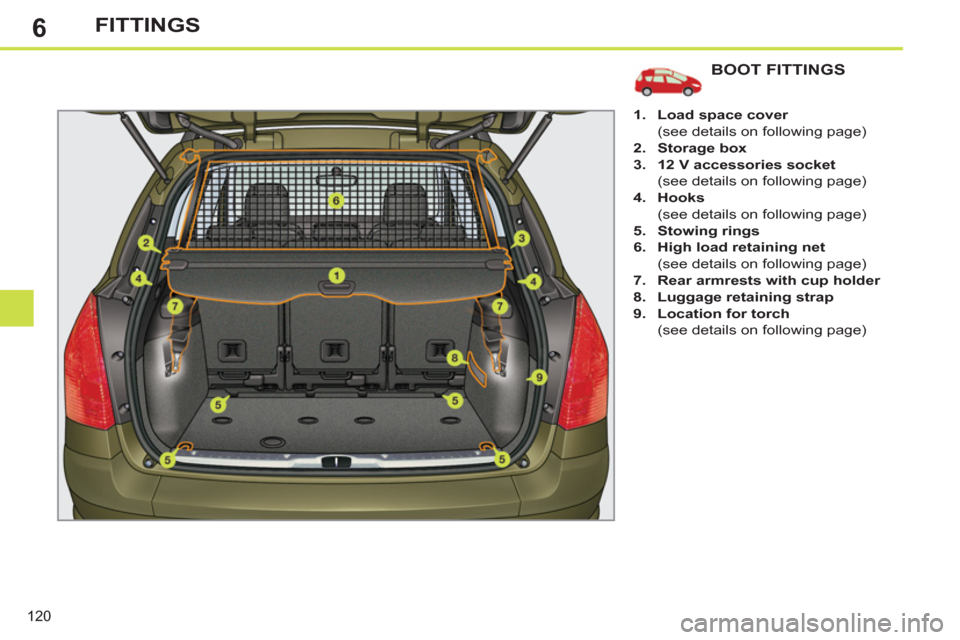
6
120
FITTINGS
BOOT FITTINGS
1.
Load space cover
(see details on following page)
2.
Storage box
3.
12 V accessories socket
(see details on following page)
4.
Hooks
(see details on following page)
5.
Stowing rings
6.
High load retaining net
(see details on following page)
7.
Rear armrests with cup holder
8.
Luggage retaining strap
9.
Location for torch
(see details on following page)
Page 137 of 356
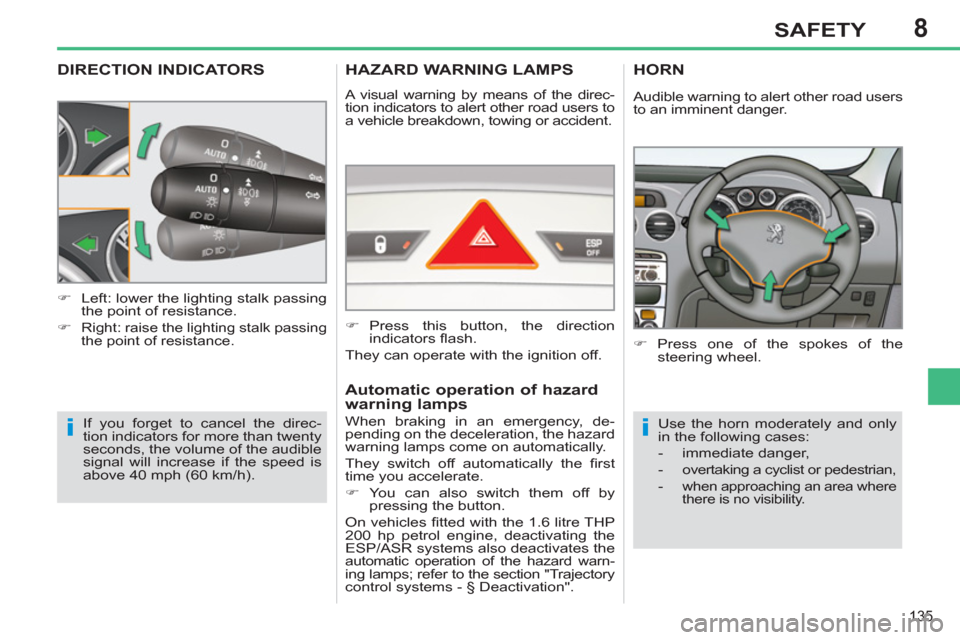
8
ii
135
SAFETY
DIRECTION INDICATORS
If you forget to cancel the direc-
tion indicators for more than twenty
seconds, the volume of the audible
signal will increase if the speed is
above 40 mph (60 km/h).
�)
Left: lower the lighting stalk passing
the point of resistance.
�)
Right: raise the lighting stalk passing
the point of resistance.
HAZARD WARNING LAMPS
A visual warning by means of the direc-
tion indicators to alert other road users to
a vehicle breakdown, towing or accident.
�)
Press this button, the direction
indicators fl ash.
They can operate with the ignition off.
Automatic operation of hazard
warning lamps
HORN
�)
Press one of the spokes of the
steering wheel.
Use the horn moderately and only
in the following cases:
- immediate danger,
- overtaking a cyclist or pedestrian,
-
when approaching an area where
there is no visibility.
Audible warning to alert other road users
to an imminent danger.
When braking in an emergency, de-
pending on the deceleration, the hazard
warning lamps come on automatically.
They switch off automatically the fi rst
time you accelerate.
�)
You can also switch them off by
pressing the button.
On vehicles fi tted with the 1.6 litre THP
200 hp petrol engine, deactivating the
ESP/ASR systems also deactivates the
automatic operation of the hazard warn-ing lamps; refer to the section "Trajectory
control systems - § Deactivation".
Page 209 of 356
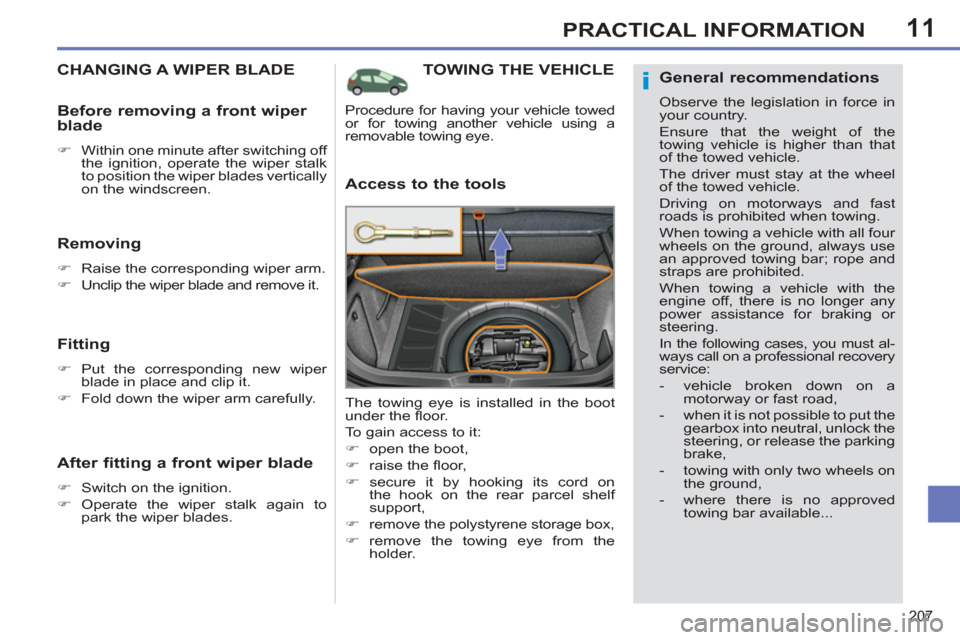
11
i
207
PRACTICAL INFORMATION
TOWING THE VEHICLE
Access to the tools
The towing eye is installed in the boot
under the fl oor.
To gain access to it:
�)
open the boot,
�)
raise the fl oor,
�)
secure it by hooking its cord on
the hook on the rear parcel shelf
support,
�)
remove the polystyrene storage box,
�)
remove the towing eye from the
holder.
Procedure for having your vehicle towed
or for towing another vehicle using a
removable towing eye.
CHANGING A WIPER BLADE
Removing
�)
Raise the corresponding wiper arm.
�)
Unclip the wiper blade and remove it.
Fitting
�)
Put the corresponding new wiper
blade in place and clip it.
�)
Fold down the wiper arm carefully.
Before removing a front wiper
blade
�)
Within one minute after switching off
the ignition, operate the wiper stalk
to position the wiper blades vertically
on the windscreen.
After fitting a front wiper blade
�)
Switch on the ignition.
�)
Operate the wiper stalk again to
park the wiper blades.
General recommendations
Observe the legislation in force in
your country.
Ensure that the weight of the
towing vehicle is higher than that
of the towed vehicle.
The driver must stay at the wheel
of the towed vehicle.
Driving on motorways and fast
roads is prohibited when towing.
When towing a vehicle with all four
wheels on the ground, always use
an approved towing bar; rope and
straps are prohibited.
When towing a vehicle with the
engine off, there is no longer any
power assistance for braking or
steering.
In the following cases, you must al-
ways call on a professional recovery
service:
- vehicle broken down on a
motorway or fast road,
- when it is not possible to put the
gearbox into neutral, unlock the
steering, or release the parking
brake,
- towing with only two wheels on
the ground,
- where there is no approved
towing bar available...
Page 210 of 356
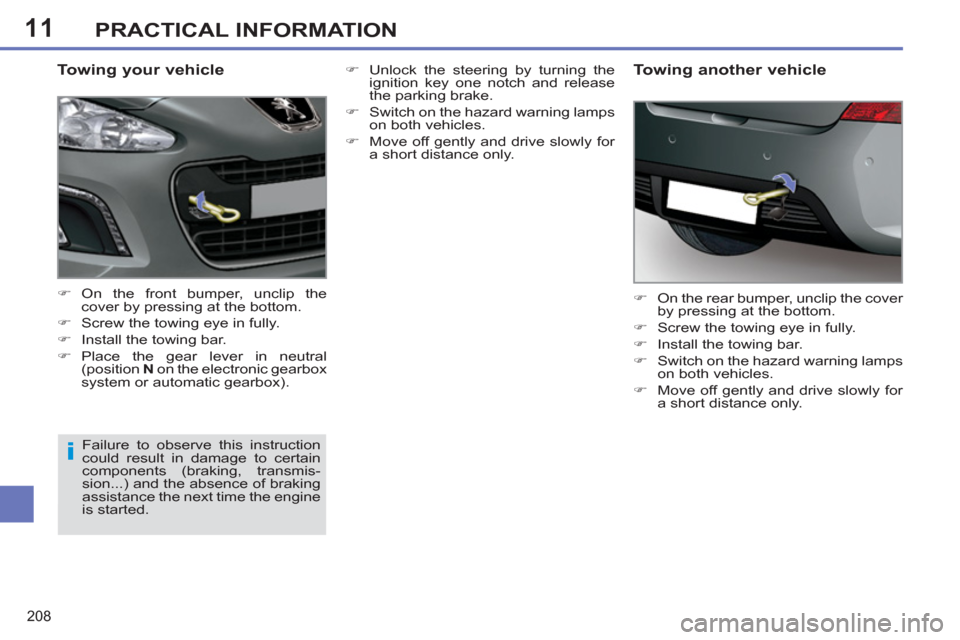
11
i
208
PRACTICAL INFORMATION
Towing your vehicle
�)
On the front bumper, unclip the
cover by pressing at the bottom.
�)
Screw the towing eye in fully.
�)
Install the towing bar.
�)
Place the gear lever in neutral
(position N
on the electronic gearbox
system or automatic gearbox).
�)
On the rear bumper, unclip the cover
by pressing at the bottom.
�)
Screw the towing eye in fully.
�)
Install the towing bar.
�)
Switch on the hazard warning lamps
on both vehicles.
�)
Move off gently and drive slowly for
a short distance only.
Towing another vehicle
Failure to observe this instruction
could result in damage to certain
components (braking, transmis-
sion...) and the absence of braking
assistance the next time the engine
is started.
�)
Unlock the steering by turning the
ignition key one notch and release
the parking brake.
�)
Switch on the hazard warning lamps
on both vehicles.
�)
Move off gently and drive slowly for
a short distance only.